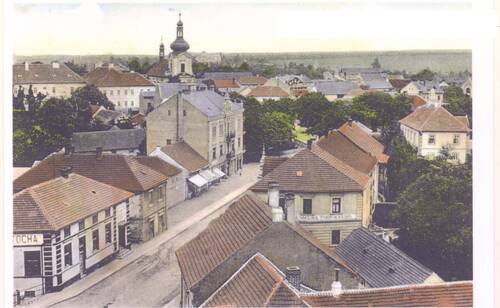|
Uhříněves Town Centre
Uhříněves is a small town approximately 15 miles south-east of Prague. Jews have lived in the area of the town since the 16th century. The census of 1890 shows that there were 43 Jewish residents, 2.9 per cent of the population of the town. The Familiant Law of 1727 set limits on the numbers of Jewish families who were allowed to live in an area.
|
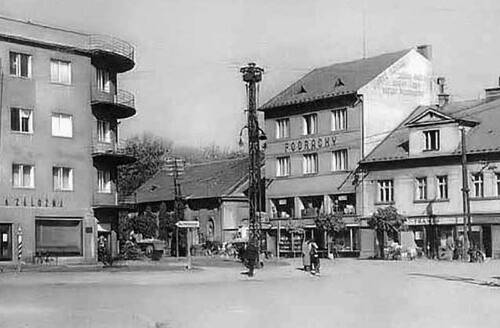 |
|
Uhříněves Synagogue
Until 1847, the local Jewish population worshipped in a family home. Public collections were organised and in 1848 the synagogue was erected in neoclassical style. Religious services took place here until the Nazi occupation in 1939. From the late 19th century to the 1920s, the community employed a rabbi. From 1949, the synagogue building was used as a laundry and in 1999 it was converted to a double-glazing showroom.
The ownership was restored to the Prague Jewish community in the 1990s.
|
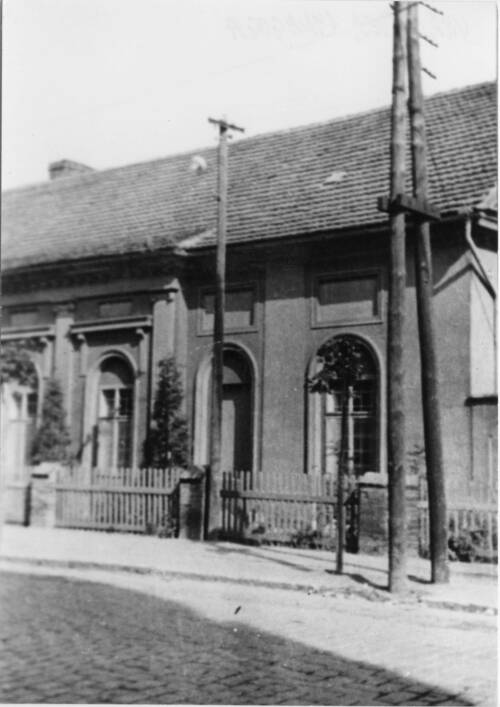 |
|
Uhříněves Synagogue Interior
The synagogue had 48 seats for men downstairs and 27 seats for women in a gallery upstairs. Until 1818 the ownership rights of the seats were recorded in a book. It is recorded “Jakub Beykovsky bought in the year 1863 the men’s seats numbers 2-9 and the women’s seat number 3 for 94 Gulden 10 Krones and ensured them with a contribution of 3 Gulden a year”.
|
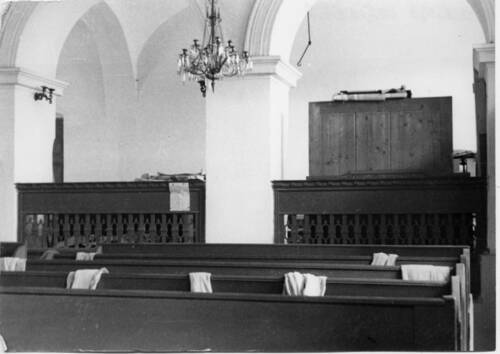 |
|
Uhříněves Synagogue Bimah and Ark
The wooden synagogue ark was designed in the classical style. Formerly it contained seven torah scrolls. The other six scrolls from the Uhříněves synagogue are on permanent loan to the Beth El Synagogue, Fort Worth, Texas; Bushey and District Synagogue; Beth Emeth Congregation, Sun City West, Arizona; B’nai B’rith Klutznik Exhibition Hall, Washington DC; Century Pine Jewish Centre, Pembroke Pines, Florida; and Temple Sinai, Atlanta, Georgia.
|
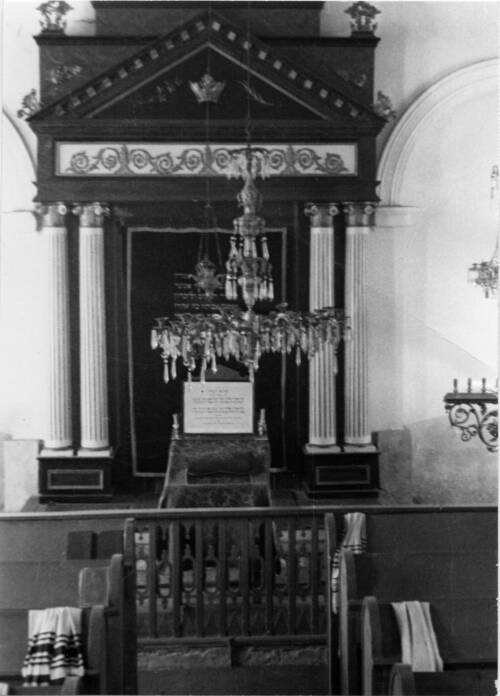 |
|
Uhříněves Synagogue Torah mantle from the Jewish Museum of Prague
The Jewish Museum in Prague has about 40 synagogue items from Uhříněves. All are textile items apart from two pointers and two shofars. The oldest item is a torah mantle from 1798.
|
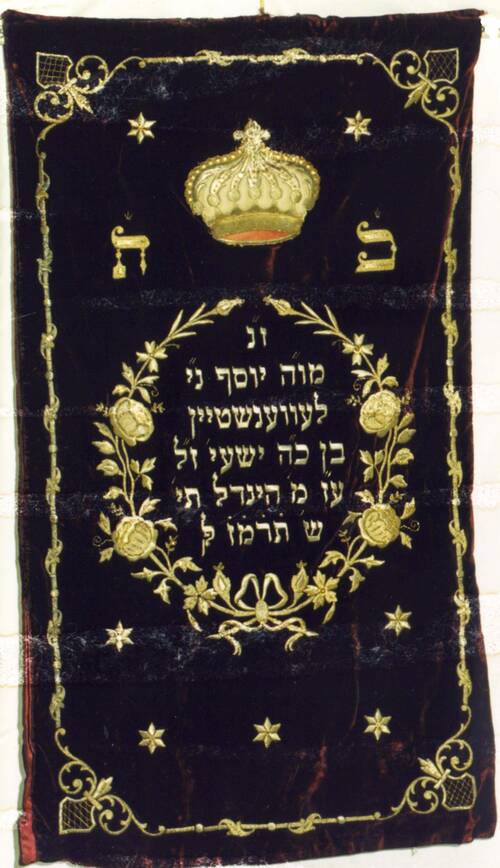 |
|
Prominent figures of the Uhříněves Jewish Community I
Rabbi Daniel Kohn, He died in 1892 after 30 years of service.
Josef Beykovsky, the first chairman of the community 1893- 1901.
Wilhelm (Vilem) Beykovsky, treasurer 1901-1919. Wilhelm was a farmer and owned an estate in Pitcovice, a nearby hamlet.
Josef Rezek, He owned a general store and a bar.
|
 |
|
Prominent figures of the Uhříněves Jewish Community II
Karel Beck, deputy president of the Benevolent Society.
Adolf Freund, council member 1903-1909 and president of the Benevolent Society.
Heinrich (Herm) Polacek, synagogue council member. He owned a textile store.
Oskar Rezek, chairman 1919-1930. He was the local butcher. Oskar was married to Olga and had three daughters. Libuse Votavova remembers that Olga and her daughter Helena taught her in primary school but Jews were then banned from teaching in 1940, and they were obliged to wear the yellow star in September 1941, then sent to Terezin and later to Auschwitz.
Mrs Votavova recounts that according to their aunt they had sent a letter saying “Tomorrow we were going to the gas chambers, we are not afraid and we will sing the national anthem “.
|
 |
|
Uhříněves Cemetery 1910
It is likely that the cemetery was established some time in the late 17th century. It contains some 300 headstones. The oldest headstones are from the early 18th century.
A number of beautiful 18th century Baroque gravestones remain, such as that of David Jehuda with an engraving of a lion dated 1747. The last burials, including Vilem Beykovsky, took place in 1942 but no stones were erected. The cemetery served the surrounding area which includes some 20 villages.
|
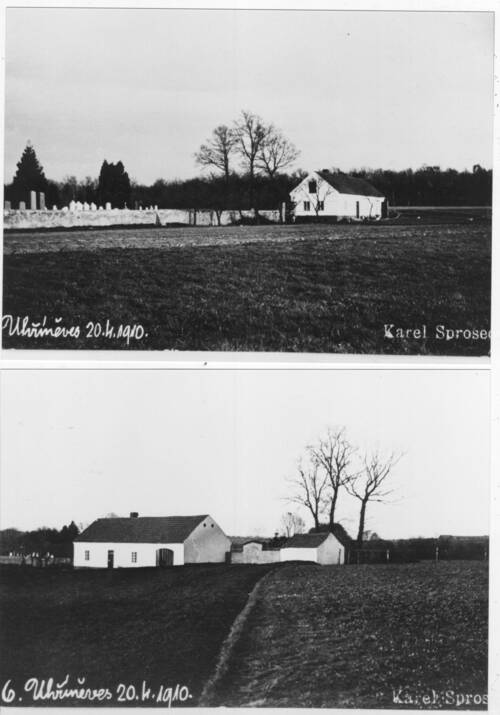 |
|
Uhříněves Cemetery
This extraordinary photograph taken in the 1960s shows a headstone that has been partially engulfed by a tree. Today the headstone has almost completely disappeared from view.
|
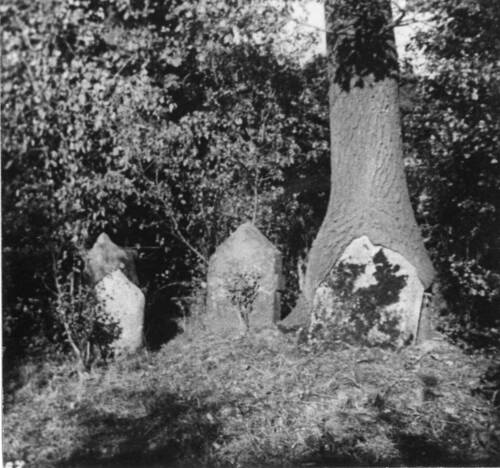 |
|
Libuse and Hana
The original photos were given to FRS by Libuse Votavova.
|
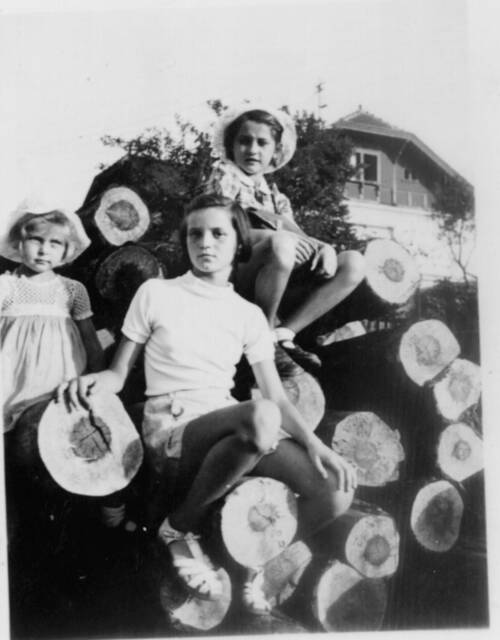
|
|
Hana’s school photo
Hana Polackova is in the second row, sixth from the right. Jirina Mullerova, another girl with Jewish ancestry is in the back row, third from left. Jirina wrote in Hana’s autograph book on 22 September 1940: “Spread love around and goodness where others have forgotten them”. Hana was transported to Terezin on transport “Bg” on 14 September 1942 and died in Maly Trostinec, a death camp in Poland, on 22 September 1942.
|
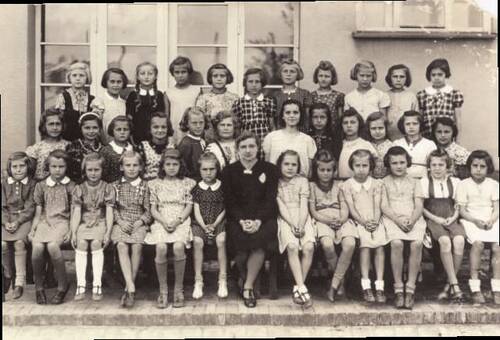 |
|
Poster for Hans Krasa’s operetta Brundibar
The Terezin concentration camp was used by the Nazis for propaganda purposes to demonstrate to the world media that Jews were being resettled in Jewish towns. To bolster this illusion, Jews were given limited freedom to engage in cultural activities such as concerts and lectures. Between 1942 and 1945, despite the appalling conditions, there was an astonishing amount of artistic and musical creativity, much of which has survived. Brundibar was by far the most successful musical entertainment produced in the ghetto. Hana Polackova remembers with nostalgia playing the part of a cat in the show.
|
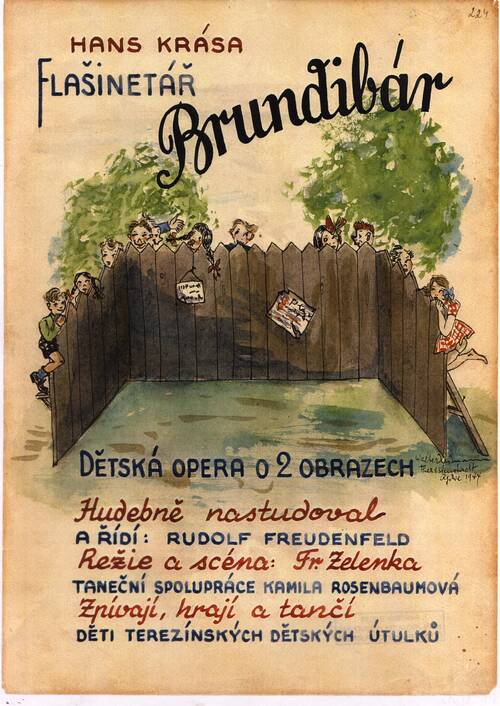 |
|
A transport of Czech Jews to Terezin (Theresienstadt)
The photo shows families walking the last part of the journey from the station in the village of Bohusovice to Terezin. Jews from Uhříněves left for Terezin from a gathering point in Prague; most of them went to Terezin on 12 September 1942 on transport “Bg”. The date coincided with the first day of Rosh Hashanah. From Terezin, the old and the weak were immediately transported east to death camps in Poland.
|
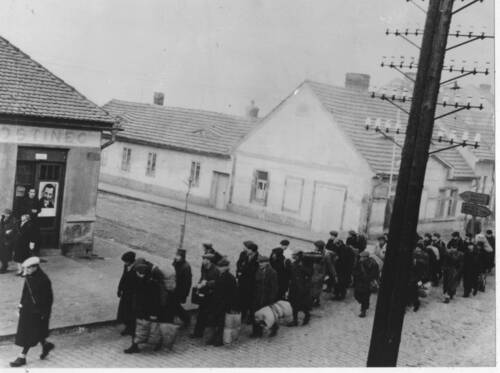 |
|
Hana Polackova and her mother 1934
Having annexed the Sudetenland in October 1938, the Nazis invaded the rest of Czechoslovakia in March 1939 and immediately imposed harsh racial laws on the Jewish population. For example, Hana was not allowed to go to school or ride a bike. On 12 September 1942, at the aged of 12, Hana was transported by the Nazis to the Terezin ghetto, a concentration camp approximately 80 miles north of Prague, leaving behind her parents in Uhříněves. Hana survived for three years in Terezin. During those dark days one of the few pleasures that Hana experienced was performing in Hans Krasa’s operetta for children, Brundibar. Finally, in September 1945, Terezin was liberated and Hana set out, barefoot, on the long journey home to Uhříněves.
|
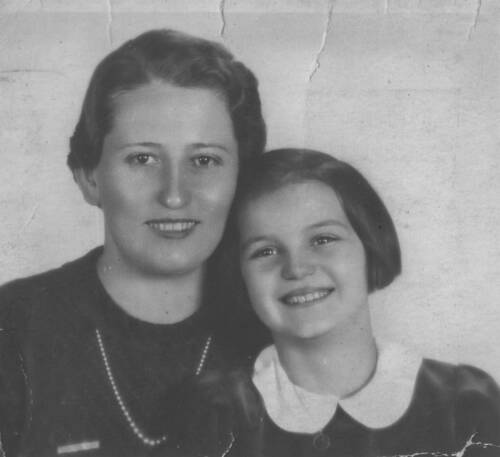 |
|
In an interview in 2003, Hana recalled the following: “In Terezín there was an epidemic of dysentery. 200 people died every day. I became seriously ill. A family friend took care of me before she had to go on a transport to Poland. Before that she managed to find me a place in the so-called Kinderheim L 410 where we were 35 to 37 kids in a place. She even found me a ‘guardian’. It was I. Krausová who took care of us until she went to Poland also. I had typhus, a chronic lung inflammation, later a spot on the lungs, rheumatoid arthritis and encephalitis. Thanks to the Jewish doctors that worked under such difficult conditions and made great sacrifices, I survived all those hardships and sufferings. I shall never forget what they did for me. In the end they too had to go on a transport to Poland.”
|
|
Libena Fleischer (from Hana Polackova’s autograph book)
“Life is not a fairy tale, life is not a dream, it is will that wins in life, work and strength” written on 4 January 1942. Helena was born in 1920. She was transported to Terezin on 12 September 1942; her final fate is unknown. Libena was offered the chance to escape to France but she refused it as she did not want to leave her parents.
|
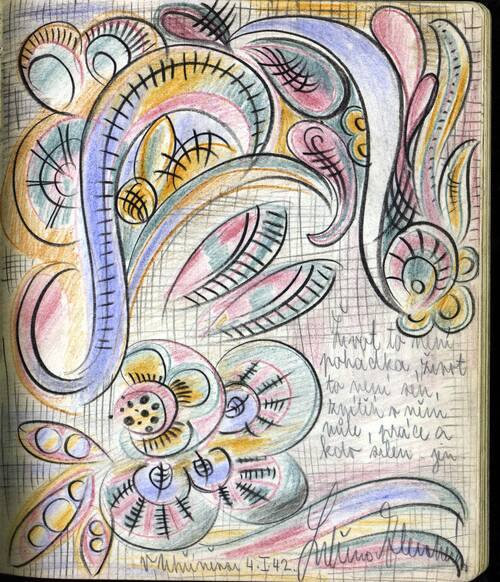 |
|
Libuse and Hana
One of Hana Krasa’s closest friends when she was growing up in Uhříněves was Libuse Votavova. The youngest child is Libuse’s sister.
|
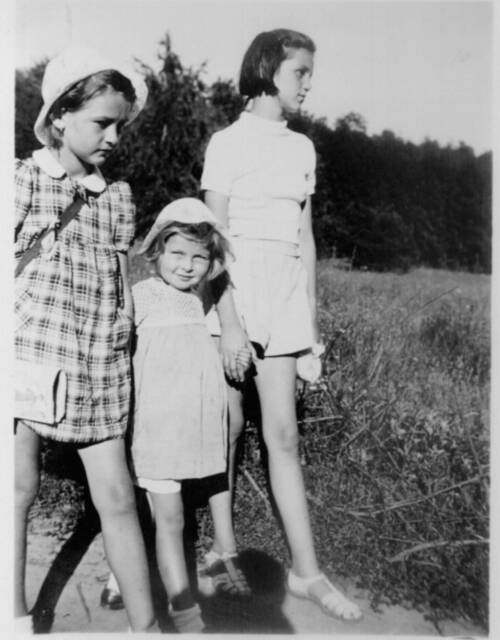 |
|
Postcard from Terezin
A postcard written by Hana Polackova in Terezin to her parents in Uhříněves. Hana had been in Terezin since September 1942.
|
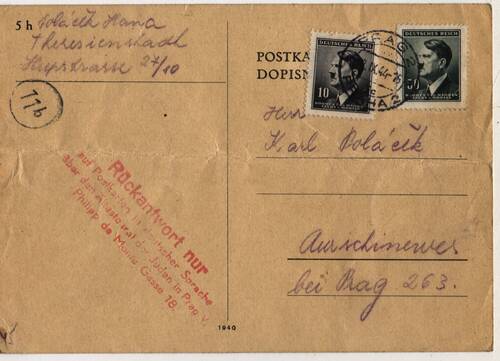 |
|
Postcard from Hana Polackova, reverse side
Hana reassures her parents that she is in good health. The postcard seems to overly stress this. From what we know of Nazi propaganda methods, it is likely that Hana was told what to write. The translation of the text from the original German:
Dear Parents, I am now with Uncle Ulli who spoke to my doctor today. The doctor is a friend of the uncle. From what the doctor says I am quite healthy and I feel very well, so there is no need for you to worry. Ulli and Lilka have received the parcels. I think of you a lot and I am very well and looking well too. I am looking forward to hearing good news from you. Love and kisses from your Hanka.
|
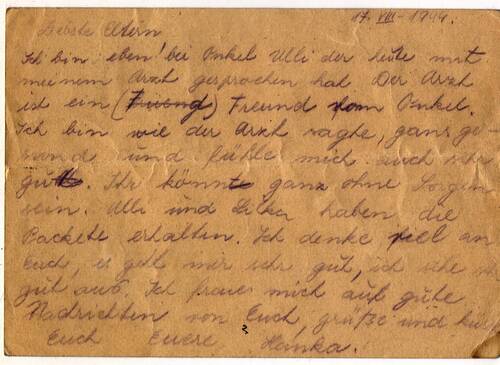 |
|
Fricek (Fritz) Neugeborn c.1935
Fricek was a friend of Hana Polackova. He lived in Letna Street, Mal Sternberska. He escaped from a transport with Hana’s help. He went into hiding from the Gestapo in Prague. Later he escaped to Ostrava and was hunted by the Gestapo. In 1945, when half of Ostrava was already liberated, he was challenged for not having his ID and was shot and killed.
|
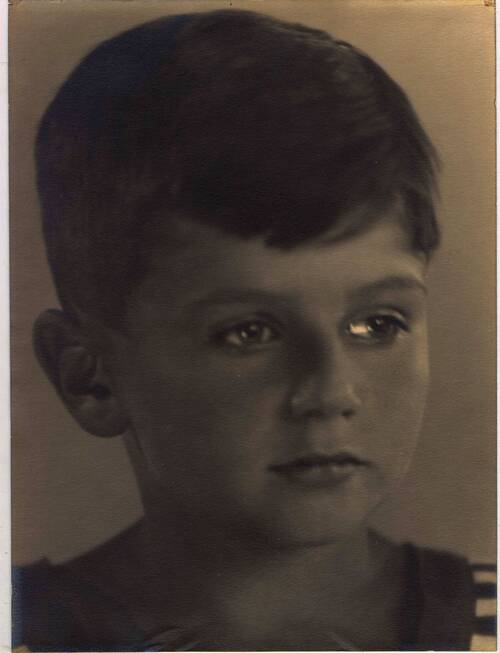 |
|
Hana Polackova in her room in the Charles Jordan Home 2002
When Libuse Votavova made enquiries to locate her old childhood friend Hana, she discovered that she was living in very poor circumstances. Libuse contacted the Jewish community on her behalf and after campaigning, Hana was eventually offered an apartment in the Charles Jordan Jewish home in Prague.
|
 |
|
Eva, Anna and Lily Dub (l to r)
Josef Rezek's daughter Irma married Robert Dub and had three daughters. Eva was born in 1925 and survived the war after being in a number of concentration camps. She was found by a deserting Jewish Russian soldier. They got married and moved to Israel. Anna and Lily were killed by the Nazis.
|
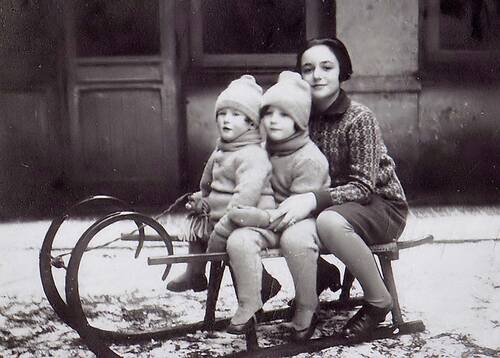 |
|
Alfred Kolben 1930
Alfred Kolben (left) with Berna’t (?) after a tennis match at the Uhříněves Lawn Tennis Club. Berna’t narrowly won 2:6, 6:3, 8:6. Alfred was executed in Maly Trostinec camp on 22 September 1942.
|
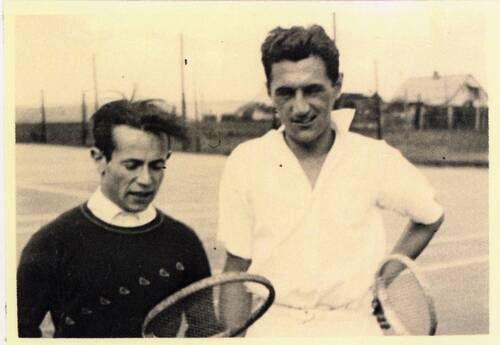 |
|
The family of Milos Jedlinsky 1936
Back row (l to r): Arnost Lustig, uncle; Jaroslava, cousin; Josef Jedlinsky, father and Jarmila Jedlinska, mother. Front row (l to r): Anna Lustigova (nee Pickova); Barbora Pickova, grandma; Leopold Pick, grandfather and Milos Jedlinsky, grandson. Milos survived but his parents Jarmilla and Josef died in Auschwitz on 18 May 1944.
|
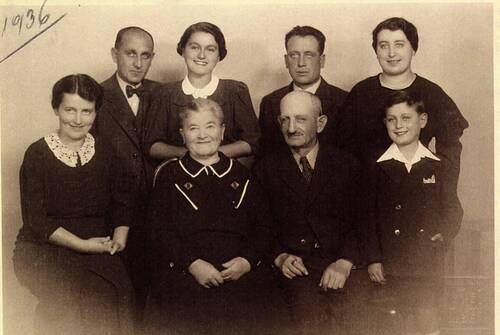 |
|
Jirina and Arnos Kraus 1939
Arnos Krauss and Jirina Wantochova on their wedding day. Jirina was born on 8 September 1911 in Uhříněves where her family owned a distillery. They were transported from Prague to Terezin on 17 May 1942 and immediately from there to Majdanek in Poland where they were killed. Frantisek Krauss, Arnos Krauss’ son by his first marriage, survived and was present at the plaque unveiling in October 2000.
|
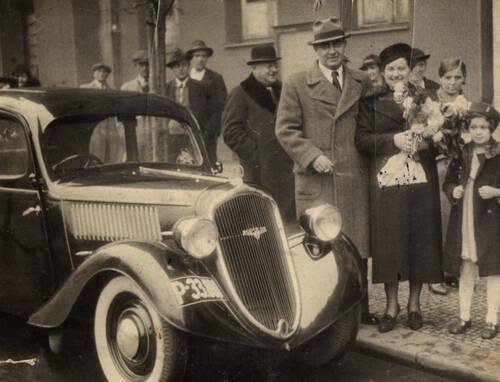 |
|
Rudolph and Paula Fischerova
|
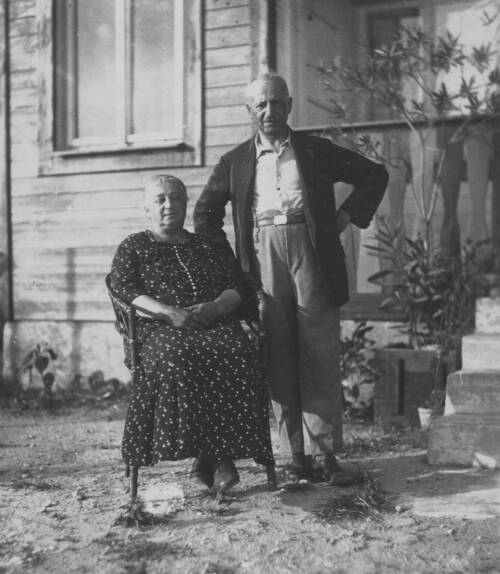 |
|
Luise and Victor Beykovsky 1915
This photograph was sent as a postcard with the following inscription: “Dear Grandfather (Josef Beykovsky) I send you this postcard of my mother taken here at the summer house. I am quite satisfied here in Pitcovice. Loving greetings to you and Uncle. From your grandson Victor 27/7/1915”.
Louise was a fine cook and her recipes have been handed down through the family until today.
|
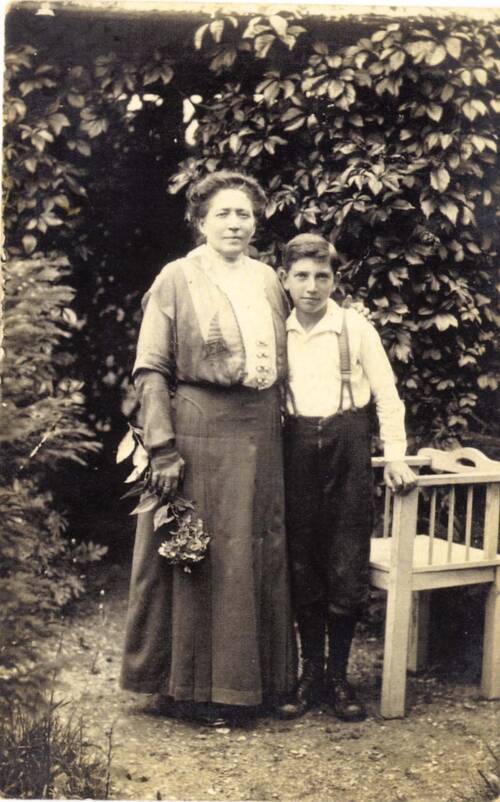 |
|
The Beykovsky farm in Pitkovice
The Beykovsky family were wealthy landowners and Julius Beykovsky lived like a country squire. His wealth and position had no influence and Julius perished in Auschwitz in 1942.
|
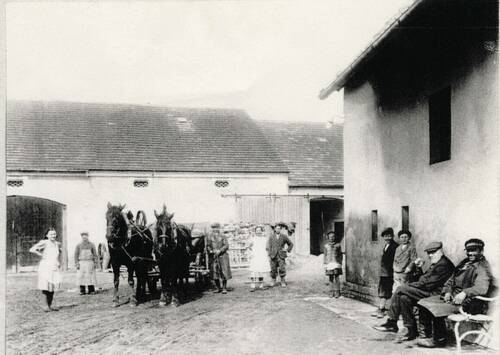 |
|
Marianne Lowe 1952
Czech scroll projects reveal strange coincidences. One of the most astonishing coincidences concerned Marianne Lowe. David Rose used the Jewish genealogical website to locate descendants of Uhříněves families. He was contacted by Peter Lowe in Hertford who said he was distantly related to the Beykovsky family of Uhříněves. David Rose says:
“I explained to Peter about the scroll and he asked me where the synagogue was located and I said Finchley. Much to my surprise he told me that his mother Marianne Lowe lived in Etchingham Park Road (a nearby road). He then asked me in which street the synagogue was located and when I told him Fallow Court Avenue he gasped and told me his sister lived in the same road. It transpired that Dorrit and her husband Eric lived in the house directly opposite the synagogue. Marianne became a regular visitor to our community until her death in 2003”.
|
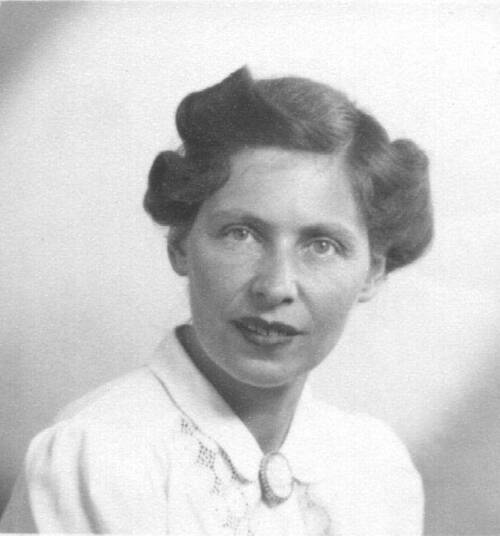 |
|
Ludwig and Anna Dux and family 1914
Ludwig and Anna Dux are shown with their daughters Ruzena and Marta in front of their textile and shoe shop opposite the synagogue. The family were transported to Terezin on transport “Bg” on 12 September 1942. Ludwig was sent to Auschwitz where he was killed but Anna and her daughters survived.
|
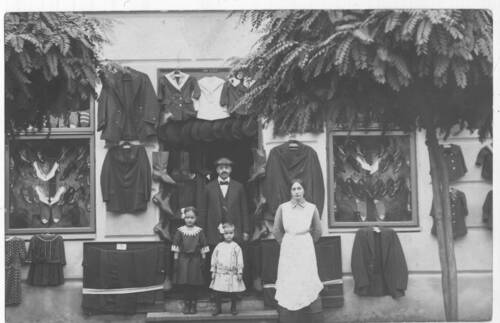 |
|
The Wantoch Family
The Wantoch family were renowned wine merchants in Uhříněves. They produced a celebrated cherry brandy. Jiri and Karel Wantoch left before the war and joined the RAF and fought in North Africa.
|
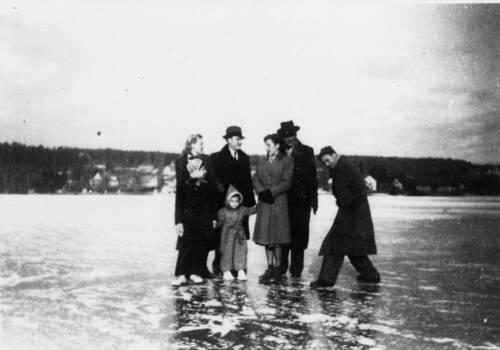 |
|
Marta, Ruzena, Villem and Anne Duxova 1917
|
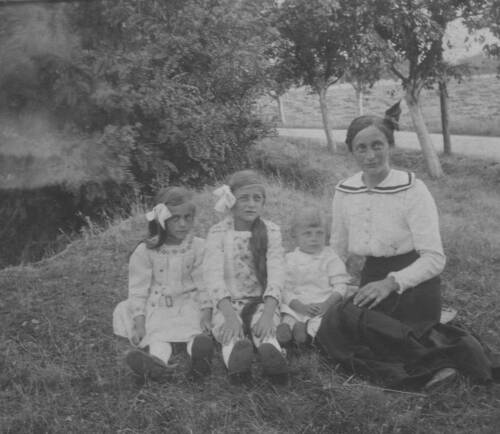 |
|
Marta Duxova
Marta Duxova was Ludwig Dux's daughter and was born on 23 November 1911. She was sent to Terezin on 8 September 1942 and returned to Uhříněves on 5 May 1945. She died on 15 December 1992.
|
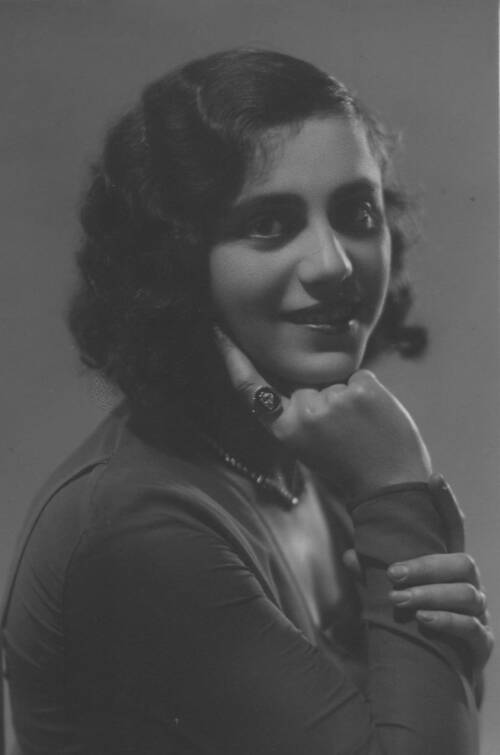 |
|
Ruzena Duxova
Ruzena Duxova was born on 6 April 1908. She joined her sister Marta in Terezin in February 1945 and was liberated in May 1945.
|
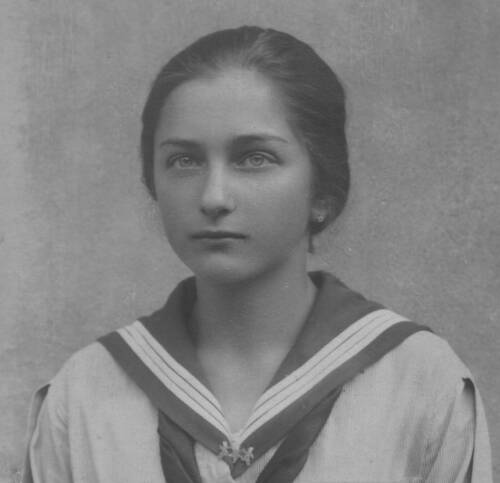 |
|
Bernard Dux 1926
Bernard Dux was the father of Ludwig and great-grandfather of Hana Kubova Duxova who still lives in the Uhříněves area. Hana visited FRS in 2000.
|
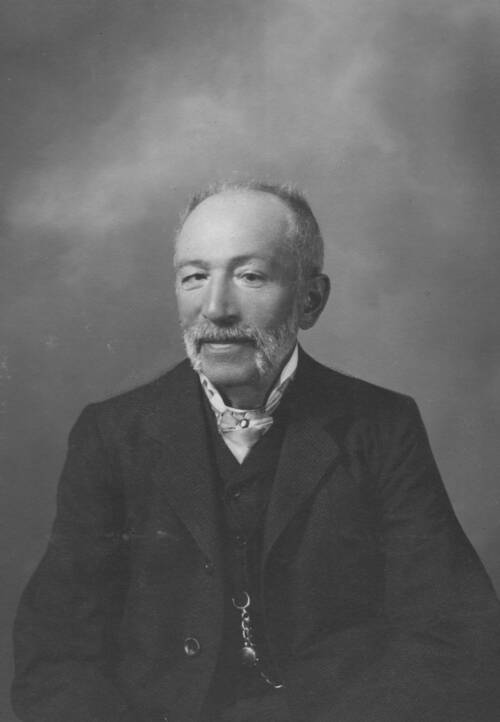 |
